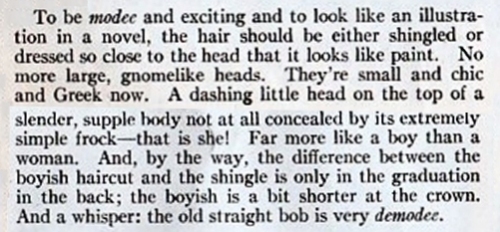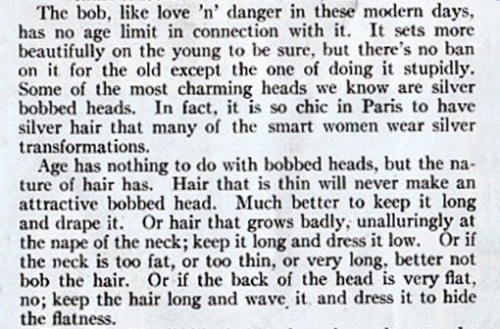
Dinner Party from a Toothpaste Ad, Delineator magazine, January, 1924. These full hairdos were about to be replaced by “slicker” head-hugging styles.
I’m not a big fan of Downton Abbey, but I watch it anyway. In the last episode I saw, in season 5, Lady Mary got a new haircut, which is certainly something lots of women do when they feel the need for a change. But there was something about her bob that bothered me, so I poked around in my files, trying to figure out what it was.
Instead, I found a lengthy article about bobbed hair, “Slicker ‘n’ Slicker,” from January 1925, plus many hair-related images. The article is long, so I’ll break the text up into readable sections (over two posts) and include period images of the styles it refers to. The author, Celia Caroline Cole, was a regular beauty columnist for Delineator magazine, and most of my images are from mid-twenties issues of Delineator.
Here is the illustration and caption that accompanied “Slicker ‘n’ Slicker”:

“One’s crowning glory is such a problem, what is a body to do? To bob or not to bob — and how?” Delineator, Jan. 1925, p. 22.
“ONE-FOURTH of the women of Paris are bobbed. And there is about that same proportion in London and New York.” — Celia Caroline Cole, Delineator, January 1925.
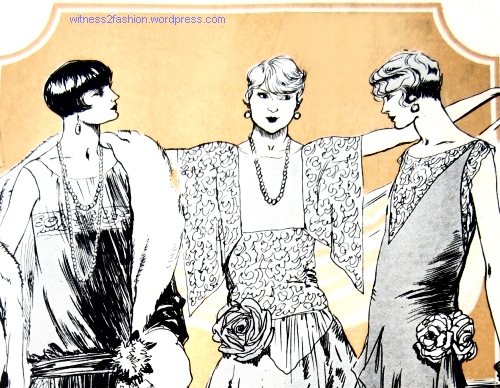
Paris fashions from Lucien Lelong, left, and Jean Patou, center and right. The models have bobbed and shingled hair. Sketched by Soulie for Delineator, late 1925.
Women Whose Hair Was Not Yet Bobbed
What about the other seventy-five percent of women, the ones who had not yet succumbed to the fashion for very short, “slick” hair?
Bobbed hair had first been popularized during World War I; dancer and fashion icon Irene (Mrs. Vernon) Castle was influential in setting the style.

Irene Castle, with bobbed hair, endorsing Corticelli Silk in this advertisement from Ladies’ Home Journal, October 1917.
However, after the war ended, long hair became fashionable again. The Marcel Wave — and later, a permanent curl — made it possible for women born with straight hair to have very wavy locks. You could even get a home permanent “outfit” (using one roller, which screwed into your lamp, like a lightbulb, since there was usually no other electrical supply in the room.) “A whole head can be waved comfortably in just a few hours.”

A Nestle Home Permanent Outfit, “Price only $15” in December, 1924. Delineator. It’s going to take more than a few hours to wave that head of hair.
My mother, like many other women, was still wearing her “marcelled” hair in the late 1920s:
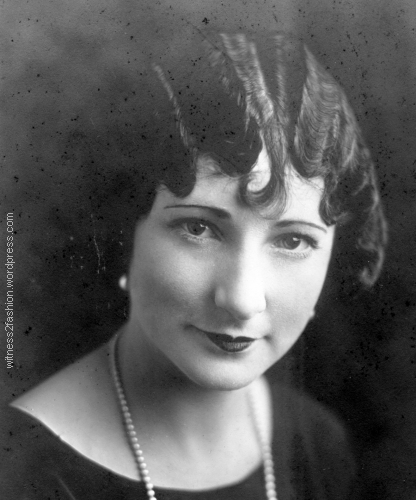
A marcel wave, worn close to the head to fit under a cloche hat in the 1920’s. Most women did not wear a curl right in the middle of their foreheads, but her center part was very typical. “A part in the middle is as smart for bobs as for long hair.”
Three models from one page of Delineator magazine, November 1924: the woman on the left has a marcel wave and long hair gathered into a chignon low on her neck. The woman on the right has a sleek bob with a “shingle” cut in back. Either style would fit under a cloche hat.
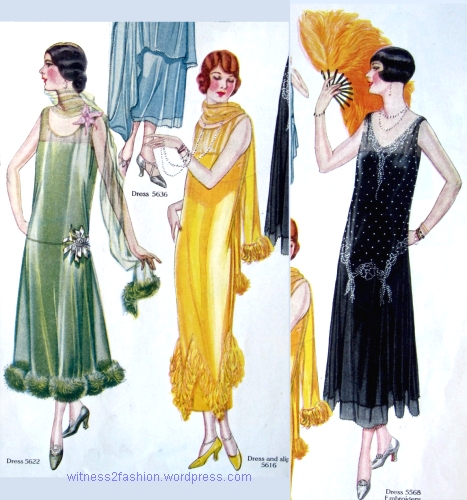
November 1924: Three hair styles seen together in one Butterick pattern illustration. Delineator, p. 27.
Return of the Bob
The fashion for bobbed hair returned in the early 1920’s. Daring young women went to the local (male) barber shop to have their “crowning glory” chopped off — sometimes to the horror of their parents.

Barber’s Display card sold to barber shops in 1924. From An Illustrated History of Hairstyles, by Marian I. Doyle, page 82.
However, in January of 1925, most women had not yet bobbed their hair. Those who had, usually wore it very full (one might say, “bushy”); the author of “Slicker ‘n’ Slicker” refers to their “large, gnomelike heads.” Ads for shampoos and other hair products emphasized a thick, wavy head of hair:

An ad for Danderine hair product, January 1925. Delineator. In the same issue, the beauty editor called these bobbed hairdos “very demodee.”
Even these styles, from the Barber Shop display card shown above, are full, rather than sleek.
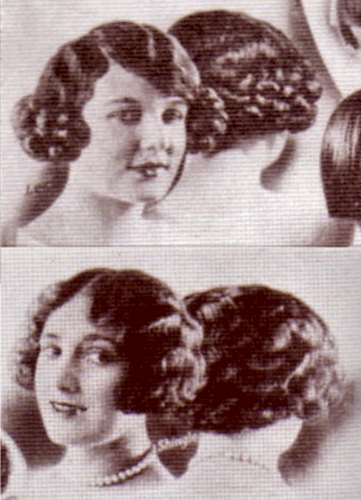
Straight bobs from barber shop display card, 1924. From An Illustrated History of Hairstyles, M. Doyle.
That is why the beauty editor of Delineator had to tell women, in January of 1925, that “the old straight bob is very demodee.” [Démodée means “out of style, unfashionable.”] “To be modee and exciting and to look like an illustration in a novel, the hair should be either shingled or dressed so close to the head that it looks like paint.” — C. C. Cole
The Shingle Explained
“If a woman has a well-shaped head . . . , the hair is cut close to the head in the back and about a third of the way up from the nape of the neck and from there on it is longer. The whole aim is to have a beautiful line for the back of the head — that loveliness one finds in the head of a young boy.
“If the hair is thin . . . , the smart hairdresser does not cut the hair close at the nape of the neck, but cuts it in one length from the crown to the nape, thinning the ends with a razor so that it will not stand out.” — Celia Cole in her article “Slicker ‘n’ Slicker.”
More Exerpts from “Slicker ‘n’ Slicker,” Published in January 1925

“A dashing little head on the top of a slender supple body not at all concealed by its extremely simple frock.” Pattern illustrations from Delineator, Feb. 1924.

Four Paris models sketched by Soulie, Delineator, January 1925 — The same issue carried “Slicker ‘n’ Slicker.”

“The short, stout woman can very rarely wear a shingle; she needs a ‘thatch.’ ” Round-U Corset ad, Dec 1924. Delineator.
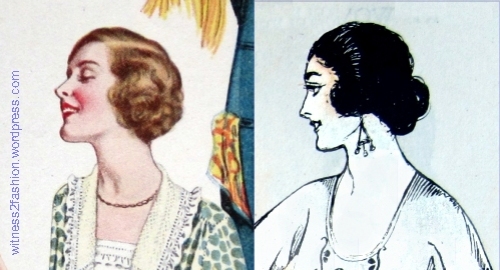
“Wave it” or “Dress it low” if a shingle doesn’t suit your hair or head shape; two styles from 1924. Delineator.
However, if a woman’s hair is thick, she should “go to a good barber — and by “barber” we mean a woman’s barber, a hairdresser — and have him thin it out evenly, so that it can be dressed smartly close.”
To be continued . . . .


